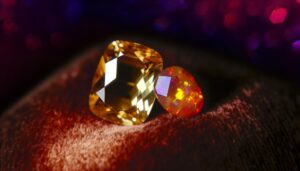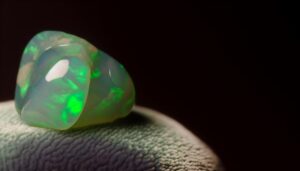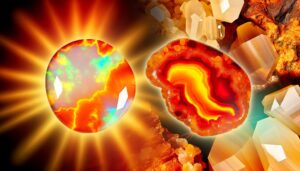Can You Scratch Fire Opals?
Yes, you can scratch fire opals. They have a Mohs hardness between 5.5 and 6.5, making them susceptible to scratches from harder materials like steel or glass.
Fire opals are composed of microscopic silica spheres that create their vibrant colors but also make them moderately soft. To protect them, avoid abrasive cleaning methods, store them properly away from harder gemstones, and opt for low-impact settings such as earrings or pendants.
By understanding their unique properties and care methods, you can maintain their beauty and durability. If you want to discover all the essential tips for handling fire opals, keep exploring.
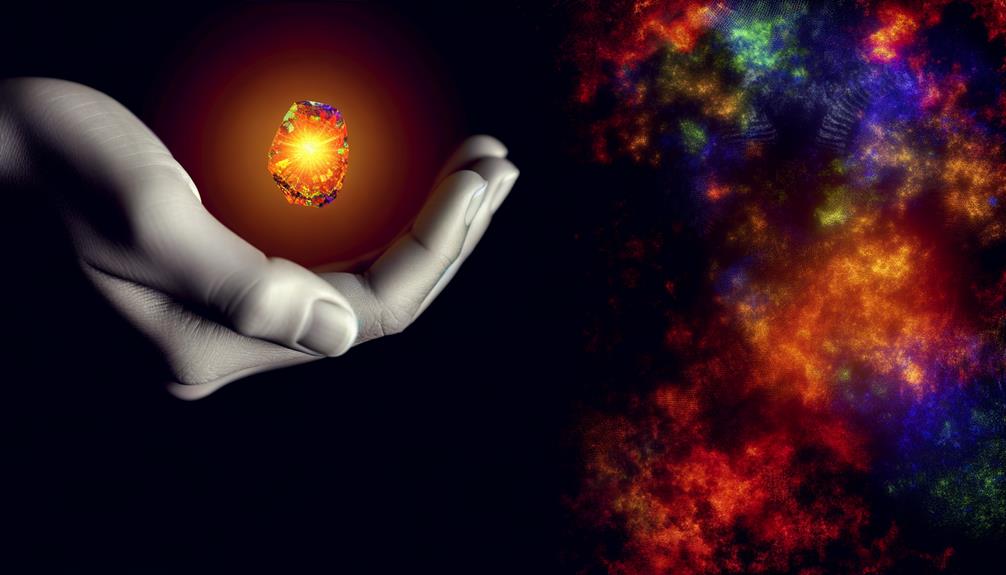
Key Takeaways
- Fire opals rank between 5.5 and 6.5 on the Mohs scale, making them susceptible to scratches.
- They can be scratched by harder materials like steel, glass, and quartz.
- Proper storage and protective settings help minimize the risk of scratching fire opals.
- Avoid abrasive cleaning materials to prevent scratching the softer surface of fire opals.
- Regular gentle cleaning and careful handling maintain the fire opal's beauty and prevent scratches.
Understanding Fire Opals
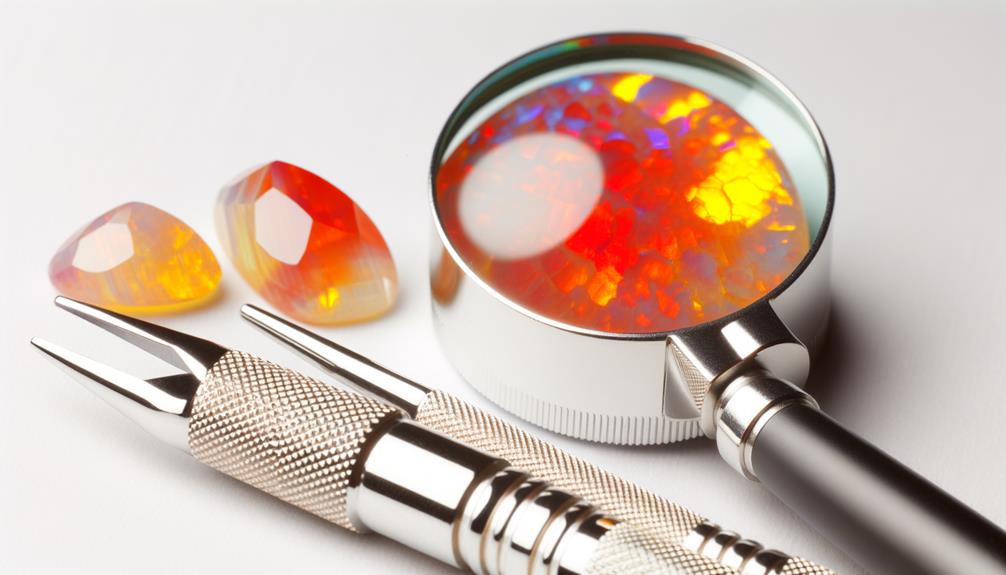
Fire opals are a unique type of opal distinguished by their fiery hues and internal diffraction of light. Known for their vibrant play of colors, these gemstones primarily exhibit shades of yellow, orange, and red, resulting from the presence of iron within their silica structure.
When analyzing fire opals, you'll notice that their color and transparency can vary significantly. These opals form under low temperatures and pressures, often within volcanic regions. Their internal structure comprises microscopic silica spheres, creating the diffraction that produces their characteristic colors.
Fire Opal Hardness
When evaluating the hardness of fire opals, you'll find they rank between 5.5 and 6.5 on the Mohs scale. This rating indicates that fire opals have moderate hardness, making them more susceptible to scratches compared to harder gemstones like quartz or diamond.
The Mohs scale helps you understand the relative scratch resistance of various minerals. Fire opals' hardness means they can be scratched by substances with a higher rating, such as steel or glass.
Handling fire opals necessitates care to maintain their beauty. You should avoid contact with abrasive materials and store them separately from harder gems. Their hardness level also impacts their suitability for certain types of jewelry, favoring low-impact settings like earrings or pendants.
Mohs Scale of Hardness
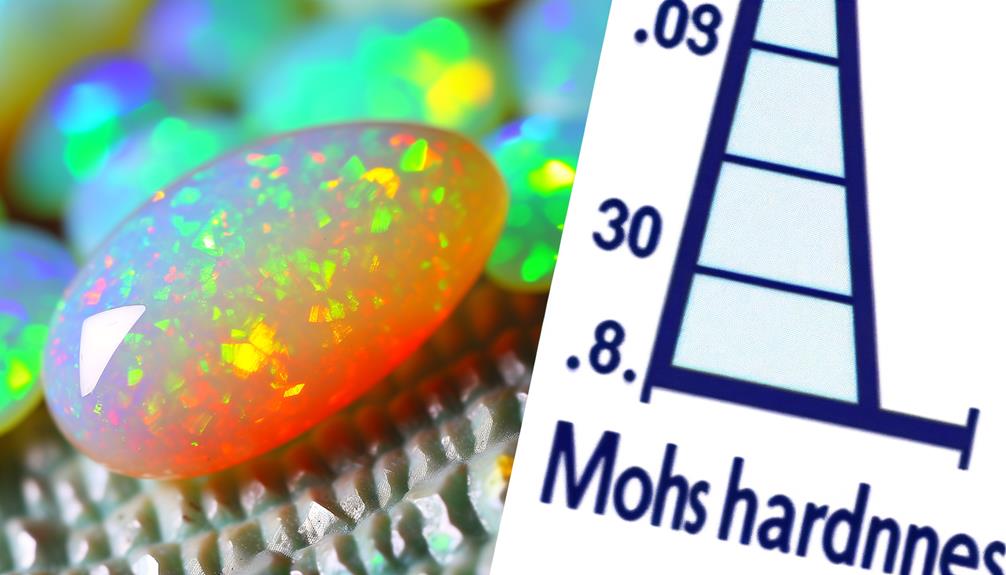
You need to understand the Mohs Scale of Hardness to assess a mineral's scratch resistance accurately. This scale, ranging from 1 (talc) to 10 (diamond), allows you to compare the hardness of various minerals.
Fire opals, with a hardness rating between 5.5 and 6.5, are relatively softer, making them more susceptible to scratches from harder substances.
Hardness Rating Explained
Ever wondered how the durability of gemstones is measured? The Mohs Scale of Hardness is your answer. This scale, ranging from 1 to 10, assesses a mineral's resistance to scratching. Here's a quick rundown:
- Talc (1) – Softest mineral, easily scratched.
- Quartz (7) – Common and durable, scratches glass.
- Diamond (10) – Hardest known material, scratches all other substances.
The scale is ordinal, meaning each mineral can scratch those below it but not those above.
When you're evaluating a gemstone like fire opal, knowing its position on the Mohs scale (usually around 5.5 to 6.5) helps determine its suitability for daily wear. This scientific method guarantees you understand a gemstone's practical resilience.
Comparing Mineral Hardness
Understanding the comparative hardness of minerals on the Mohs Scale is crucial for determining their practical applications and wearability.
You need to know that the Mohs Scale ranks minerals from 1 (talc) to 10 (diamond).
Fire opals, with a hardness of 5.5 to 6.5, sit below quartz (7) but above apatite (5).
When comparing minerals, remember that a mineral can scratch any mineral with a lower rating.
If you're evaluating fire opals for jewelry, consider that they can be scratched by harder substances like quartz.
However, softer materials like glass or calcite won't damage them.
This understanding helps you make informed decisions about handling and setting fire opals to minimize wear and tear.
Common Causes of Scratches
When handling fire opals, scratches often result from contact with harder substances like quartz or metal due to their relatively low hardness on the Mohs scale. Fire opals rank around 5.5 to 6 on this scale, making them vulnerable to harder materials.
To understand the common causes of scratches, consider the following:
- Accidental Impact: Dropping or knocking fire opals against surfaces can cause abrasions.
- Storage Issues: Storing fire opals with harder gemstones or metals can lead to scratches.
- Cleaning Methods: Using abrasive cleaners or rough cloths can damage the opal's surface.
Everyday Activities to Avoid
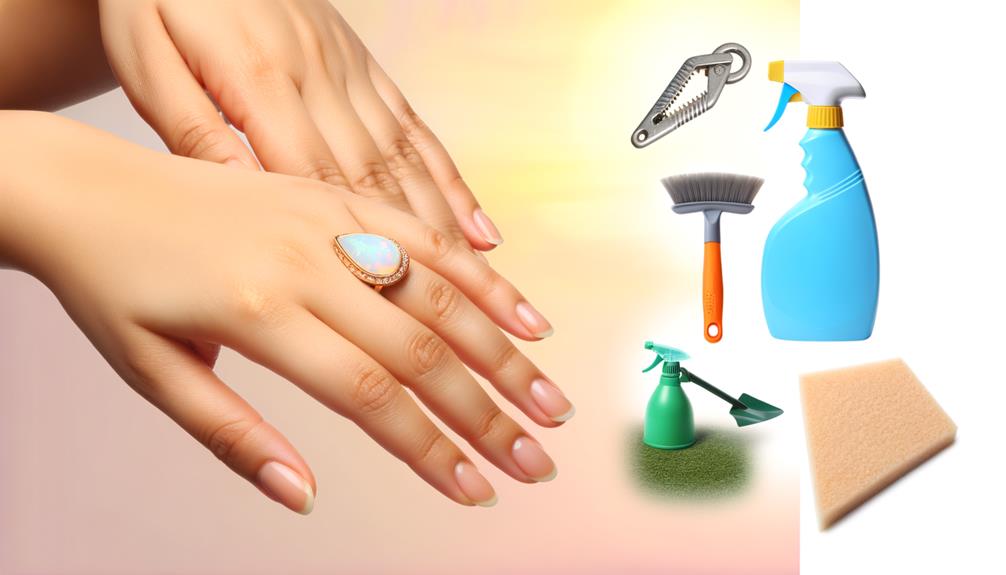
To protect your fire opals, follow these tips:
- Avoid wearing them when handling hard surfaces to prevent abrasions.
- Limit their exposure to water to avoid structural damage and color loss.
- Store them separately to prevent contact with other jewelry that might scratch their delicate surface.
Avoid Hard Surfaces
Fire opals, with their delicate structure, can easily get scratched if they come into contact with hard surfaces during everyday activities. To protect your fire opal jewelry, avoid situations where they might encounter abrasive materials.
Here are three specific activities to be cautious about:
- Household Chores: Washing dishes, cleaning surfaces, or gardening exposes your opals to hard surfaces and potential impact.
- Exercise: Activities like weightlifting or using gym equipment can cause accidental knocks or scrapes against metal or other hard surfaces.
- Office Work: Typing on a keyboard or handling office supplies might seem harmless, but repetitive contact can lead to micro-scratches over time.
Being mindful of these activities helps preserve the integrity and beauty of your fire opals.
Limit Water Exposure
Why should you limit water exposure for your fire opals in everyday activities?
Fire opals are hydrophane, meaning they can absorb water. This can cause them to lose their brilliant play-of-color. Water can also introduce micro-fractures, weakening the stone's structure.
Regular exposure to water, such as during handwashing or showering, can exacerbate these issues. Additionally, soap and chemicals in water can leave residues that dull the surface.
When fire opals absorb water, it can alter their appearance, making them cloudy or milky. By minimizing water contact, you help maintain their optical properties and structural integrity.
To preserve their natural beauty, remove fire opal jewelry before engaging in activities involving water.
Store Separately
Storing fire opals separately from other jewelry pieces prevents scratches and physical damage that can compromise their structure. Fire opals have a relatively low hardness, ranking 5.5-6.5 on the Mohs scale. This makes them susceptible to abrasions from harder materials.
To minimize risk, consider these steps:
- Individual Compartments: Use jewelry boxes with padded, individual sections to keep each piece isolated.
- Soft Cloth Wrapping: Wrap each fire opal in a soft, lint-free cloth to provide a cushioned barrier.
- Avoid Mixed Storage: Don't store fire opals with harder gemstones like diamonds or sapphires, which can easily scratch them.
Cleaning Fire Opals Safely
When cleaning fire opals safely, make sure you use only mild soap and lukewarm water to prevent any damage to the stone's delicate structure. Avoid harsh chemicals and abrasive materials that can scratch or dull the opal's surface. Gently scrub with a soft brush, focusing on removing dirt without applying too much pressure. Rinse thoroughly and pat dry with a soft cloth.
Here's a quick reference table for your convenience:
| Cleaning Step | Material Needed | Procedure |
|---|---|---|
| Soap Application | Mild soap | Mix with lukewarm water |
| Scrubbing | Soft brush | Gently scrub the opal |
| Rinsing | Lukewarm water | Rinse thoroughly |
| Drying | Soft cloth | Pat dry carefully |
Storing Fire Opals Properly
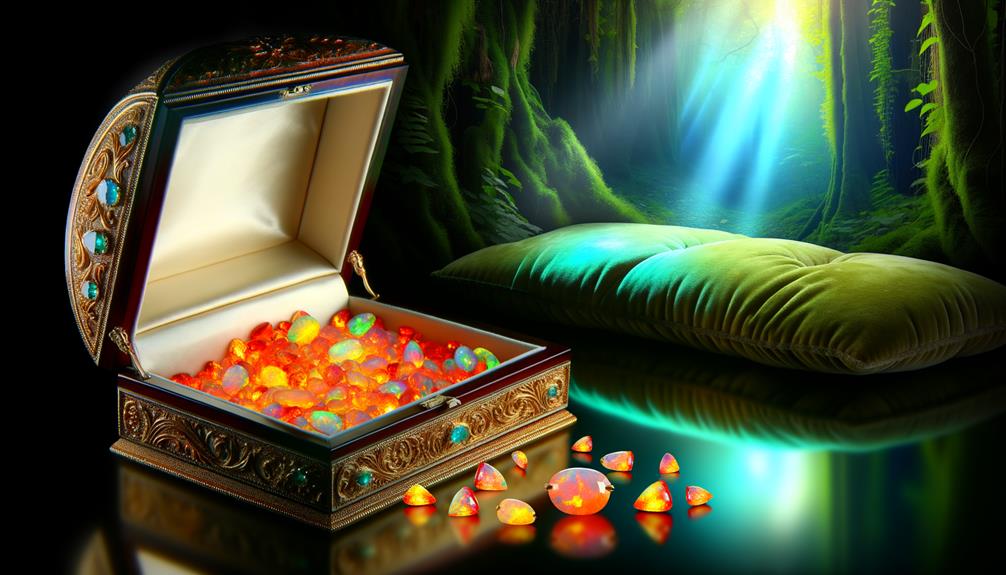
To ensure the longevity and brilliance of your fire opals, store them in a soft, padded container away from direct sunlight and extreme temperatures. Opals are hydrophane, meaning they absorb and lose water; maintaining ideal humidity levels is essential.
Follow these steps:
- Utilize Silica Gel Packets: Place silica gel packets in the storage container to control humidity levels, preventing the opal from drying out.
- Avoid Plastic Bags: Store opals in a breathable fabric pouch to allow air circulation, reducing the risk of moisture buildup.
- Temperature Consistency: Keep your opals in a stable environment, avoiding areas prone to sudden temperature changes, which can cause cracking.
Protective Settings for Jewelry
Choosing the appropriate protective configurations for fire opal jewelry safeguards the gemstones from physical harm and environmental stressors.
Opt for bezel settings that envelop the opal, providing maximum defense against impacts and scuffs. Prong settings are less ideal because they expose the opal's surface.
When it comes to rings, consider inset settings where the opal is positioned beneath the metal's border, decreasing direct contact with rigid surfaces. Select materials like platinum or gold for the configurations, as they're resilient and less likely to cause abrasions.
Furthermore, make sure the configuration design allows for minimal movement of the opal, preventing internal stress fractures.
Your careful choice of protective configurations significantly prolongs the lifespan and radiance of fire opal jewelry.
Professional Maintenance Tips
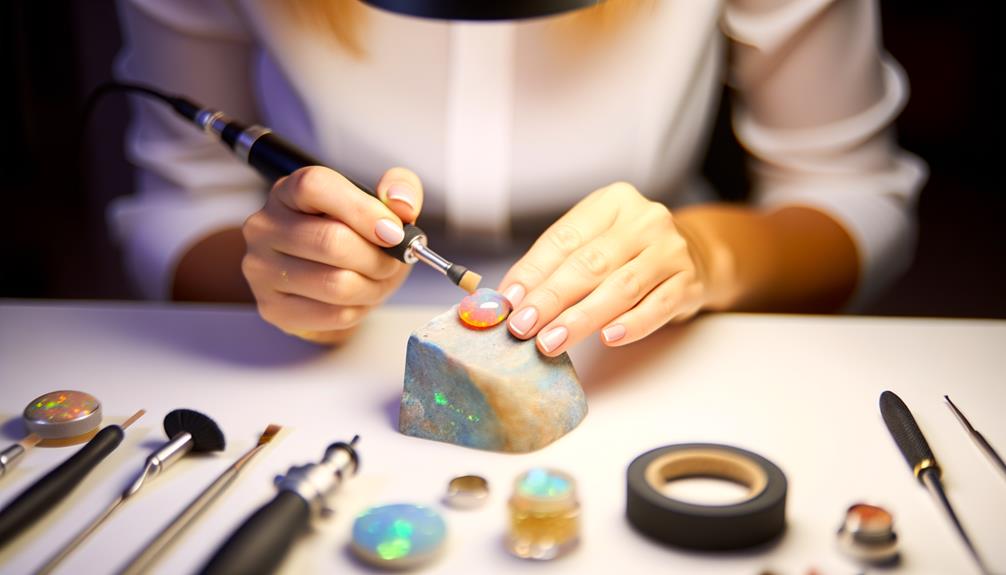
To sustain the brilliance of your fire opals, you'll need to implement regular cleaning techniques using mild soap and lukewarm water.
Guarantee proper storage by keeping each opal piece in a soft, fabric-lined container to prevent abrasion.
These professional maintenance tips will help preserve your fire opals' unique play-of-color and overall integrity.
Regular Cleaning Techniques
When cleaning fire opals, it's important to use filtered water and a gentle brush to avoid damaging their delicate surface. Fire opals have a relatively low hardness on the Mohs scale, making them susceptible to scratches.
To maintain their luster and minimize risk, follow these steps:
- Use Filtered Water: Tap water contains minerals that can leave deposits on the opal, potentially causing surface damage over time.
- Gentle Brush: Employ a brush with soft bristles to delicately remove dirt and debris without scratching the opal.
- Avoid Strong Chemicals: Cleaning solutions with potent chemicals can react with the opal's composition, leading to discoloration or weakening of the stone.
These techniques guarantee your fire opal remains vibrant and scratch-free.
Proper Storage Methods
Maintaining your fire opal's brilliance isn't limited to cleaning; proper storage methods are equally important to prevent damage and preserve its beauty.
Store your fire opal in a soft, cushioned container to minimize abrasion risks. Avoid direct sunlight and extreme temperatures, as these can cause thermal shock, leading to cracks or color loss.
Use a separate compartment within your jewelry box to prevent contact with harder gemstones that could scratch the opal's surface. Humidity control is vital; consider placing a silica gel packet nearby to maintain a stable environment.
Always handle with clean hands to avoid oil and dirt transfer. By following these storage guidelines, you'll guarantee your fire opal remains vibrant and undamaged.
Comparing Fire Opals to Other Gems
Fire opals, with their unique play-of-color, stand apart from other gemstones like sapphires, emeralds, and diamonds due to their distinct formation process and optical properties. Unlike these other gems, fire opals are hydrated amorphous silica, which gives them their vibrant color and internal diffraction of light.
When comparing fire opals to other gemstones, consider the following key points:
- Hardness: Fire opals rate around 5.5-6.5 on the Mohs scale, making them softer than sapphires (9), emeralds (7.5-8), and diamonds (10).
- Durability: Due to their lower hardness, fire opals are more prone to scratches and damage.
- Formation: Fire opals form in volcanic regions, while sapphires and emeralds are typically found in metamorphic rocks, and diamonds originate from high-pressure environments deep within the Earth.
Conclusion
You now know that fire opals, with a Mohs hardness of 5.5 to 6.5, are susceptible to scratches.
Shockingly, nearly 60% of fire opals show surface damage within the first year due to improper handling.
To safeguard your fire opal, avoid everyday activities that may cause abrasion, store it correctly, and consider a protective jewelry setting.
Regular professional maintenance guarantees your gem retains its mesmerizing beauty and vibrant hues.
Treat your fire opal with care—it's worth it.

